Influence of the Density in Binderless Particleboards Made from Sorghum
Abstract
:1. Introduction
2. Materials and Methods
2.1. Materials
2.2. Methods
2.2.1. Board Manufacture
2.2.2. Experimental Tests
3. Results
3.1. Physical Properties
3.2. Mecanical Properties
3.3. Statistical Analysis
3.4. Comparison with European Standards
4. Discussion
5. Conclusions
Author Contributions
Funding
Institutional Review Board Statement
Informed Consent Statement
Data Availability Statement
Acknowledgments
Conflicts of Interest
References
- IPCC. Summary for Policymakers. In Global Warming of 1.5 °C. An IPCC Special Report on the Impacts of Global Warming of 1.5 °C above Pre-Industrial Levels and Related Global Greenhouse Gas Emission Pathways, in the Context of Strengthening the Global Response to the Threat of Climate Change, Sustainable Development, and Efforts to Eradicate Poverty; World Meteorological Organization: Geneva, Switzerland, 2018; 32p. [Google Scholar]
- European Commission. Communication From The Commission to the European Parliament, The European Council, The Council, The European Economic and Social Committee and the Committee of the Regions. In The European Green Deal; European Commission: Brussels, Belgium, 2019; COM/2019/640 final. [Google Scholar]
- Ley 22/2011 de 28 de Julio, de Residuos y Suelos Contaminados. BOE, Boletín Oficial del Estado. 2011. Available online: https://www.boe.es/buscar/act.php?id=BOE-A-2011-13046 (accessed on 7 March 2022).
- FAO; UNEP. The State of the World’s Forests 2020. Forests, Biodiversity and People; FAO & UNEP: Rome, Italy, 2020; ISBN 978-92-5-132419-6. [Google Scholar] [CrossRef]
- European Commission. Communication from the Commission to the European Parliament, the Council, the European Economic and Social Committee and the Committee of the Regions. In A New EU Forest Strategy: For Forests and the Forest-Based Sector; European Commission: Brussels, Belgium, 2013; SWD/2013/0343 final. [Google Scholar]
- FAOSTAT. Available online: https://www.fao.org/faostat/en/#search/sorghum (accessed on 7 March 2022).
- Mantau, U.; Saal, U.; Prins, K.; Steierer, F.; Lindner, M.; Verkerk, H.; Eggers, J.; Leek, N.; Oldenburguer, J.; Asikainen, A.; et al. Real Potential for Changes in Growth and Use of EU Forests; EUwood: Hamburg, Germany, 2010. [Google Scholar]
- Kurokochi, Y.; Sato, M. Effect of surface structure, wax and silica on the properties of binderless board made from rice straw. Ind. Crops Prod. 2015, 77, 949–953. [Google Scholar] [CrossRef]
- Ferrandez-Garcia, C.C.; Garcia-Ortuño, T.; Ferrandez-Garcia, M.T.; Ferrandez-Villena, M.; García, C.E.F. Fire-resistance, physical, and mechanical characterization of binderless rice straw particleboards. BioResources 2017, 12, 8539–8549. [Google Scholar] [CrossRef]
- Xu, J.; Sugawara, R.; Widyorini, R.; Han, G.; Kawai, S. Manufacture and properties of low-density binderless particleboard from kenaf core. J. Wood Sci. 2004, 50, 62–67. [Google Scholar] [CrossRef]
- Widyorini, R.; Xu, J.; Watanabe, T.; Kawai, S. Chemical changes in steam-pressed kenaf core binderless particleboard. J. Wood Sci. 2005, 51, 26–32. [Google Scholar] [CrossRef]
- Ferrández-Garcia, M.T.; Ferrández-García, C.E.; Andreu-Rodriguez, J.; Ferrández-Villena, M.; García-Ortuño, T. The suitability of utilising cotton stalk for low cost binderless panels. In Proceedings of the 41 International Symposium on Agricultural Engineering, University of Zagreb Faculty of Agriculture, Opatija, Croatia, 19–22 February 2013; pp. 388–392. [Google Scholar]
- Nonaka, S.; Umemura, K.; Kawai, S. Characterization of bagasse binderless particleboard manufactured in high-temperature range. J. Wood Sci. 2013, 59, 50–56. [Google Scholar] [CrossRef]
- Van Dam, J.E.; van den Oever, M.J.; Keijsers, E.R. Production process for high density high performance binderless boards from whole coconut husk. Ind. Crops Prod. 2004, 20, 97–101. [Google Scholar] [CrossRef]
- Ferrandez-Villena, M.; Ferrandez-Garcia, C.E.; García-Ortuño, T.; Ferrandez Garcia, A.; Ferrandez-Garcia, M.T. Study of the utilisation of almond residues for low-cost panels. Agronomy 2019, 9, 811. [Google Scholar] [CrossRef] [Green Version]
- Amirou, S.; Zerizer, A.; Pizzi, A.; Haddadou, I.; Zhou, X. Particleboards production from date palm biomass. Eur. J. Wood Wood Prod. 2013, 71, 717–723. [Google Scholar] [CrossRef]
- Saadaoui, N.; Rouilly, A.; Fares, K.; Rigal, L. Characterization of date palm lignocellulosic by-products and self-bonded composite materials obtained thereof. Mater. Des. 2013, 50, 302–308. [Google Scholar] [CrossRef]
- Hegazy, S.; Ahmed, K.; Hiziroglu, S. Oriented strand board production from water-treated date palm fronds. BioResources 2014, 10, 448–456. [Google Scholar] [CrossRef] [Green Version]
- Laemsak, N.; Okuma, M. Development of boards made from oil palm frond II: Properties of binderless boards from steam-exploded fibers of oil palm frond. J. Wood Sci. 2000, 46, 322–326. [Google Scholar] [CrossRef]
- Lammaming, J.; Sulaiman, O.; Sugimoto, T.; Hashim, R.; Said, N.; Sato, M. Influence of chemical components of oil palm on properties of binderless particleboard. BioResources 2013, 8, 3358–3371. [Google Scholar] [CrossRef] [Green Version]
- Henao, E.M.; Quintana, G.C.; Ogunsile, B.O. Development of binderless fiberboards from steam-exploded and oxidized oil palm wastes. BioResources 2014, 9, 2922–2936. [Google Scholar]
- Ferrández-García, A.; Ferrández-Villena, M.; Ferrández-García, C.E.; García-Ortuño, T.; Ferrández-García, M.T. Potential Use of Phoenix canariensis Biomass in Binderless Particleboards at Low Temperature and Pressure. BioResources 2017, 12, 6698–6712. [Google Scholar] [CrossRef] [Green Version]
- Widyorini, R.; Yudha, A.P.; Prayitno, T.A. Some of the properties of binderless particleboard manufactured from bamboo. Wood Res. J. 2011, 2, 89–93. [Google Scholar] [CrossRef]
- Ferrandez-Garcia, A.; Ferrandez-Garcia, M.T.; Ortuño, T.G.; Mata-Cabrera, F.; Ferrandez-Villena, M. Analysis of the Manufacturing Variables of Binderless Panels Made of Leaves of Olive Tree (Olea europaea L.) Pruning Waste. Agronomy 2021, 12, 93. [Google Scholar] [CrossRef]
- Ferrandez-Garcia, C.; Andreu-Rodriguez, J.; Ferrandez-Villena, M.; Ferrandez-Garcia, M.T.; Garcia-Ortuno, T. Properties of thermal insulating panels from sorghum waste. In Proceedings of the 41 International Symposium on Agricultural Engineering, Actual Tasks on Agricultural Engineering, Opatija, Croatia, 22 February 2013; pp. 19–22. Available online: http://atae.agr.hr/Zbornik_2013.pdf (accessed on 8 June 2022).
- Iswanto, A.H.; Azhar, I.; Supriyanto, M.; Susilowati, A. Effect of resin type, pressing temperature and time on particleboard properties made from sorghum bagasse. Agric. For. Fish. 2014, 3, 62–66. [Google Scholar] [CrossRef]
- Kusumah, S.S.; Umemura, K.; Yoshioka, K.; Miyafuji, H.; Kanayama, K. Utilization of sweet sorghum bagasse and citric acid for manufacturing of particleboard I: Effects of pre-drying treatment and citric acid content on the board properties. Ind. Crops Prod. 2016, 84, 34–42. [Google Scholar] [CrossRef] [Green Version]
- Kusumah, S.S.; Umemura, K.; Guswenrivo, I.; Yoshimura, T.; Kanayama, K. Utilization of sweet sorghum bagasse and citric acid for manufacturing of particleboard II: Influences of pressing temperature and time on particleboard properties. J. Wood Sci. 2017, 63, 161–172. [Google Scholar] [CrossRef] [Green Version]
- Kusumah, S.S.; Arinana, A.; Hadi, Y.S.; Guswenrivo, I.; Yoshimura, T.; Umemura, K.; Tanaka, S.; Kanayama, K. Utilization of sweet sorghum bagasse and citric acid in the manufacturing of particleboard. III: Influence of adding sucrose on the properties of particleboard. BioResources 2017, 12, 7498–7514. [Google Scholar] [CrossRef]
- Sutiawan, J.; Hadi, Y.S.; Nawawi, D.S.; Abdillah, I.B.; Zulfiana, D.; Lubis, M.A.R.; Nugroho, S.; Astuti, D.; Zhao, Z.; Handayani, M.; et al. The properties of particleboard composites made from three sorghum (Sorghum bicolor) accessions using maleic acid adhesive. Chemosphere 2022, 290, 133163. [Google Scholar] [CrossRef] [PubMed]
- EN 326; Wood-Based Panels, Cutting and Inspection. Part 1: Sampling and Cutting of Test Pieces and Expression of Test. European Committee for Standardization: Brussels, Belgium, 1994.
- EN 309; Particleboards. Definitions and Classification. European Committee for Standardization: Brussels, Belgium, 2005.
- EN 312; Particleboards—Specifications. European Committee for Standardization: Brussels, Belgium, 2010.
- EN 323; Wood-Based Panels. Determination of Density. European Committee for Standardization: Brussels, Belgium, 1993.
- EN 317; Particleboards and Fiberboards. Determination of Swelling in Thickness after Immersion in Water. European Committee for Standardization: Brussels, Belgium, 1993.
- EN 310; Wood-Based Panels. Determination of Modulus of Elasticity in Bending and of Bending Strength. European Committee for Standardization: Brussels, Belgium, 1993.
- EN 319; Particleboards and Fiberboards. Determination of Tensile Strength Perpendicular to the Plane of de Board. European Committee for Standardization: Brussels, Belgium, 1993.
- Pintiaux, T.; Viet, D.; Vandenbossche, V.; Rigal, L.; Rouilly, A. Binderless materials obtained by thermo-compressive processing of lignocellulosic fibers: A comprehensive review. BioResources 2015, 10, 1915–1963. [Google Scholar]
- Ferrandez-Villena, M.; Ferrandez-Garcia, C.E.; Garcia-Ortuño, T.; Ferrandez-Garcia, A.; Ferrandez-Garcia, M.T. The influence of processing and particle size on binderless particleboards made from Arundo donax L. rhizome. Polymers 2020, 12, 696. [Google Scholar] [CrossRef] [PubMed] [Green Version]
- Hashim, R.; Wan Nadhari, W.N.A.; Sulaiman, O.; Kawamura, F.; Hiziroglu, S.; Sato, M.; Sugimoto, T.; Seng, T.G.; Tanaka, R. Characterization of raw materials and manufactured binderless particleboard from oil palm biomass. Mater. Des. 2011, 32, 246–254. [Google Scholar] [CrossRef]
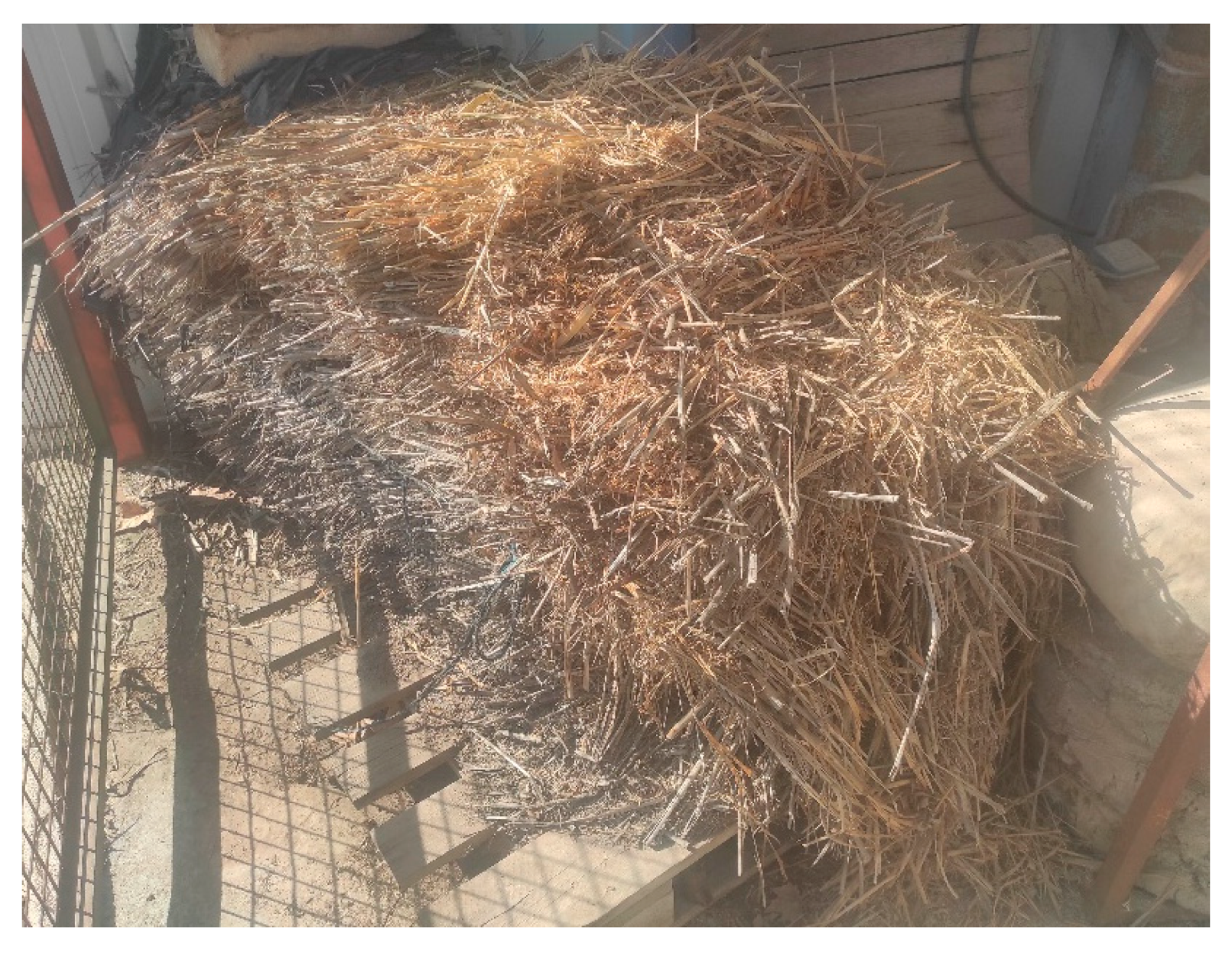
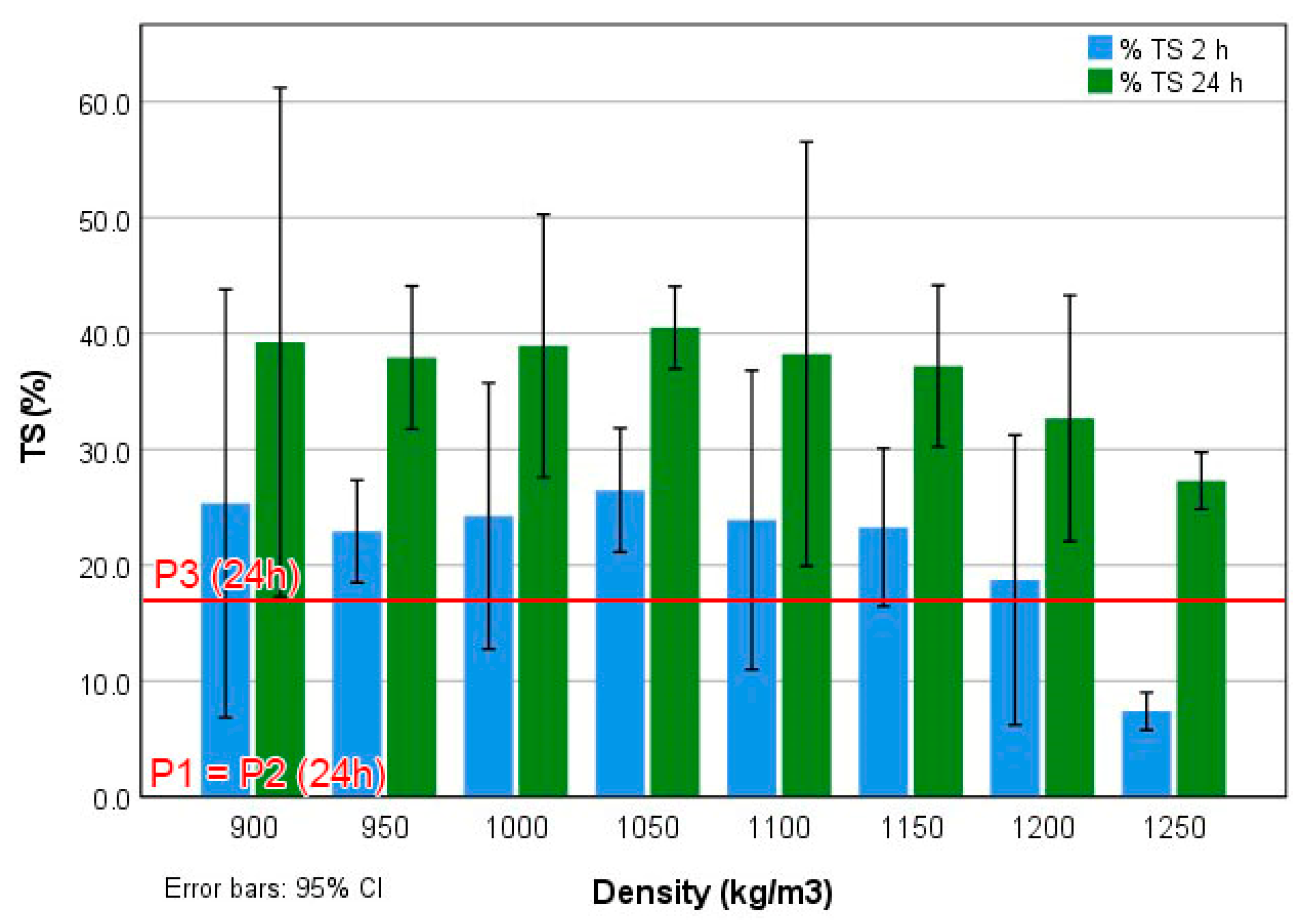
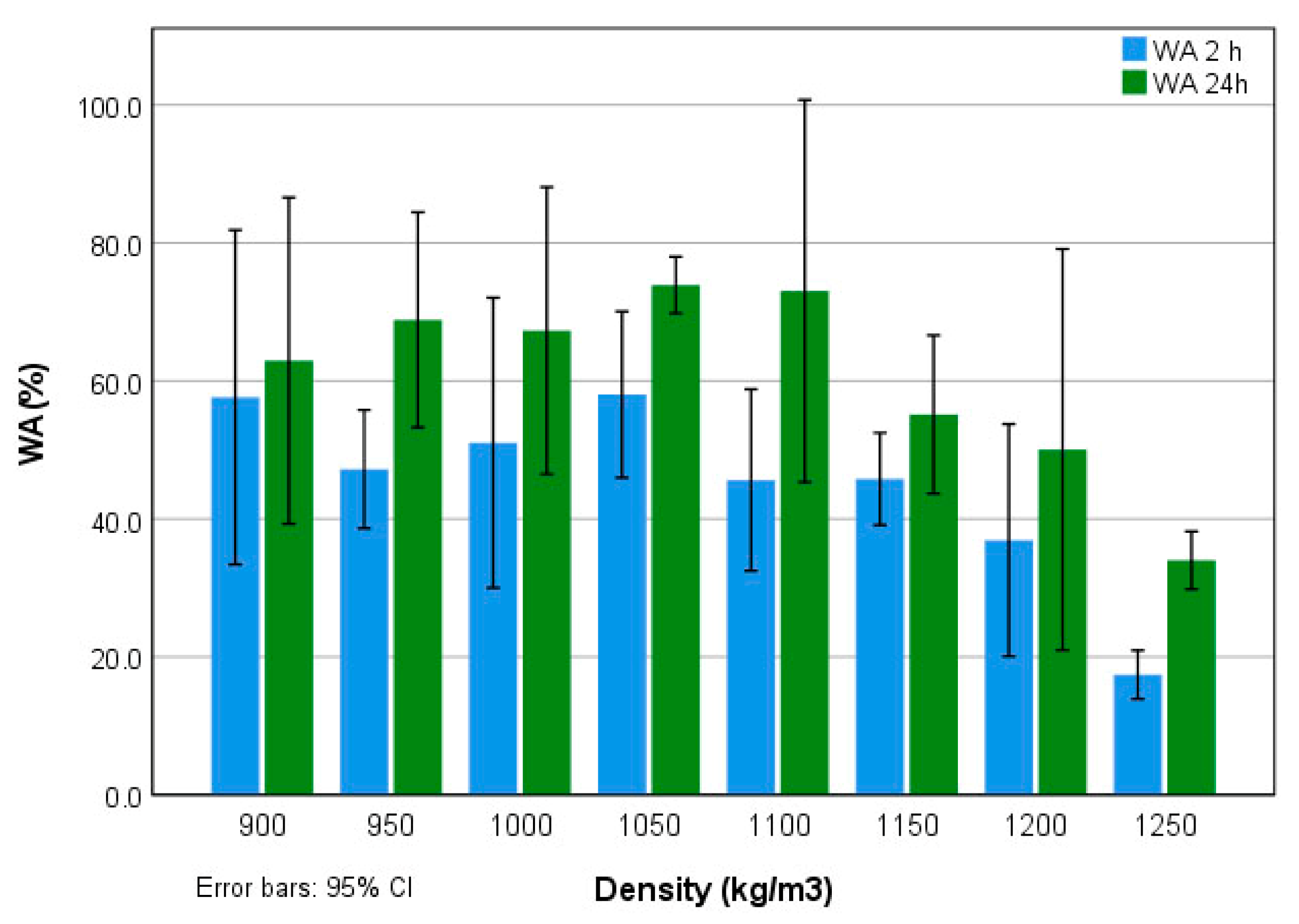
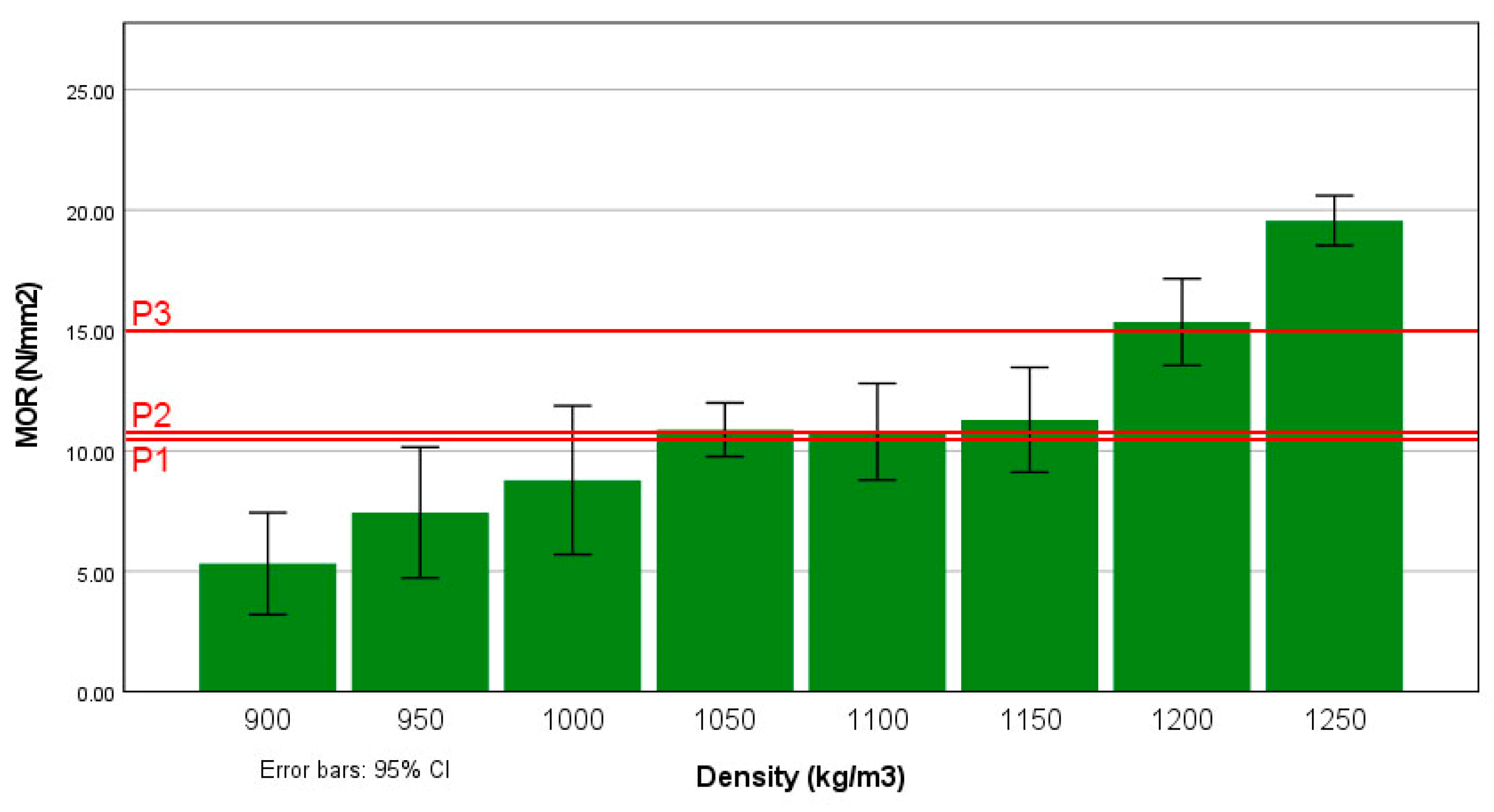
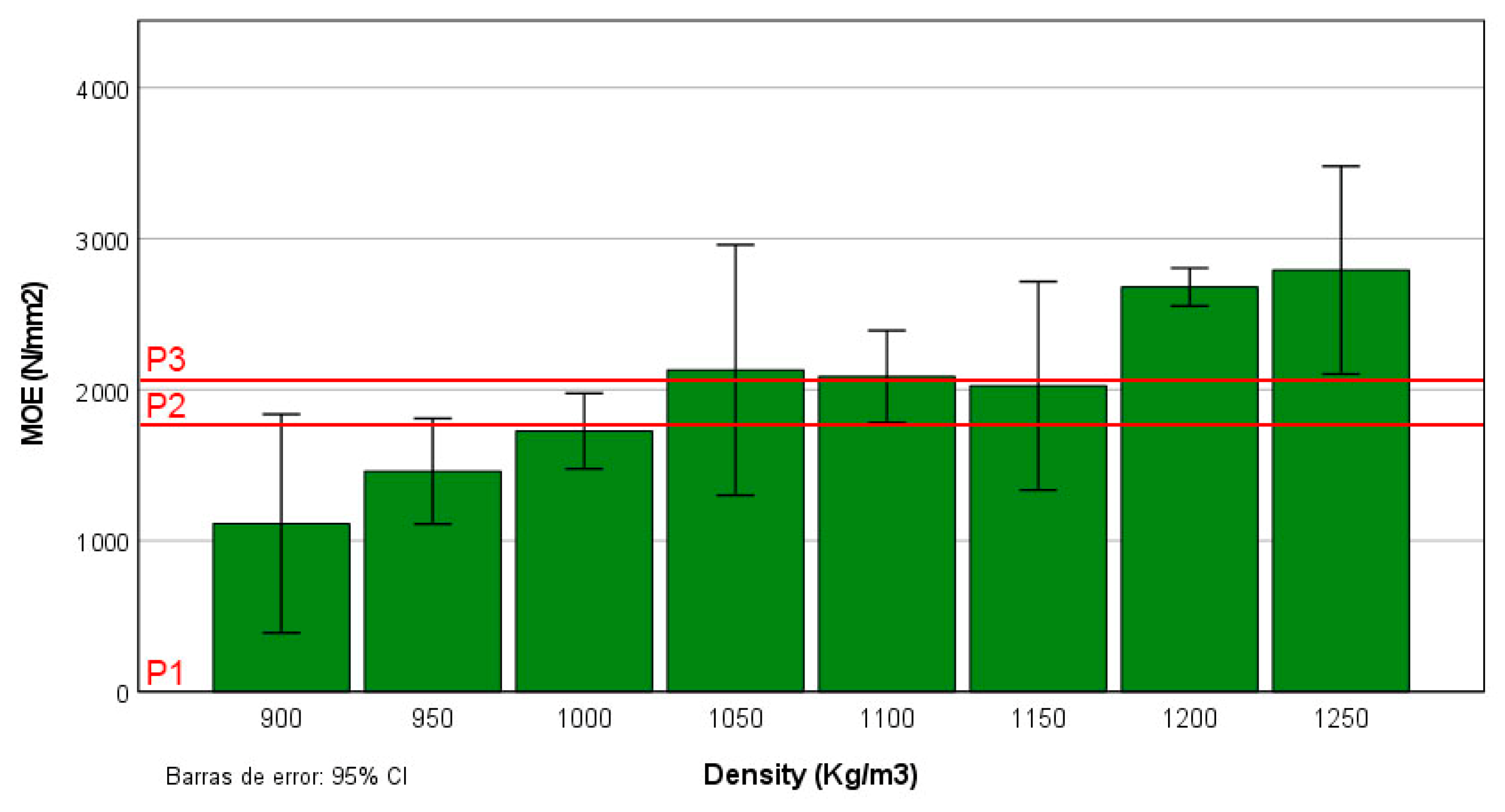

| Panel Type | Number | Density (kg/m3) | Particle Size | Time (min) | Temp. (°C) |
|---|---|---|---|---|---|
| 900 | 4 | 900 | <0.25 | 30 | 110 |
| 950 | 4 | 950 | |||
| 1000 | 4 | 1000 | |||
| 1050 | 4 | 1050 | |||
| 1100 | 4 | 1100 | |||
| 1150 | 4 | 1150 | |||
| 1200 | 4 | 1200 | |||
| 1250 | 4 | 1250 |
| Panel Type | 900 | 950 | 1000 | 1050 | 1100 | 1150 | 1200 | 1250 |
|---|---|---|---|---|---|---|---|---|
| Target density (kg/m3) | 900 | 950 | 1000 | 1050 | 1100 | 1150 | 1200 | 1250 |
| Average density (kg/m3) | 912.9 | 976.3 | 1014.5 | 1069.3 | 1104.7 | 1146.9 | 1208.8 | 1250.8 |
| Standard deviation | 11.88 | 7.87 | 5.17 | 13.68 | 23.34 | 8.29 | 17.54 | 14.03 |
| Factor | Properties | Sum of Squares | d.f. | Half Quadratic | F | p-Value |
|---|---|---|---|---|---|---|
| Density | TS 2 h (%) | 1058.092 | 7 | 151.156 | 3.425 | 0.011 |
| TS 24 h (%) | 538.283 | 7 | 76.898 | 1.338 | 0.276 | |
| WA 2 h (%) | 4791.327 | 7 | 684.475 | 7.870 | 0.000 | |
| WA 24 h (%) | 5194.868 | 7 | 742.124 | 4.986 | 0.001 | |
| MOR (N/mm2) | 568.118 | 7 | 81.160 | 46.028 | 0.000 | |
| MOE (N/mm2) | 9,070,832.001 | 7 | 1,295,833.143 | 10.688 | 0.000 | |
| IB (N/mm2) | 0.281 | 7 | 0.040 | 39.564 | 0.000 |
| Panel Type | MOR (N/mm2) | MOE (N/mm2) | IB (N/mm2) | TS 24 h (%) |
|---|---|---|---|---|
| 900 | 5.32 | 1113 | 0.05 | 39.25 |
| 950 | 7.44 | 1460 | 0.10 | 37.93 |
| 1000 | 8.79 | 1726 | 0.10 | 38.94 |
| 1050 | 10.88 | 2130 | 0.13 | 40.51 |
| 1100 | 10.80 | 2087 | 0.16 | 38.25 |
| 1150 | 11.29 | 2026 | 0.17 | 37.21 |
| 1200 | 15.35 | 2680 | 0.21 | 32.68 |
| 1250 | 19.57 | 2792 | 0.37 | 27.29 |
| Type P1 [33] | 10.50 | - | 0.28 | - |
| Type P2 [33] | 11.00 | 1800 | 0.40 | - |
| Type P3 [33] | 15.00 | 2050 | 0.45 | 17.00 |
| Source | Material | Temp. (°C) | Time (min) | Density (kg/m3) | TS 24 h (%) | MOR (N/mm2) | MOE (N/mm2) | IB (N/mm2) |
|---|---|---|---|---|---|---|---|---|
| [39] | Giant reed rhizome | 110 | 7 + 7 | 883 | 52.73 | 14.24 | 1904 | 0.75 |
| [17] | Date palm | 180 | 2 | 1200 | 150.00 | 8.40 | 928 | 0.13 |
| [40] | Oil palm | 180 | 20 | 800 | 20.00 | 13.57 | 0.71 | |
| [22] | Canary palm | 120 | 30 | 850 | 27.56 | 13.00 | 1468 | 0.40 |
| [9] | Rice straw | 110 | 30 + 30 | 1140 | 53.75 | 15.09 | 2697 | 0.18 |
| This work | Sorghum | 110 | 30 | 1250 | 27.29 | 19.57 | 2792 | 0.37 |
| Source | Binder | Particle Size (mm) | Temp. (°C) | Press. (MPa) | Time (min) | Density (kg/m3) | TS 24 h (%) | MOR (N/mm2) | MOE (N/mm2) | IB (N/mm2) |
|---|---|---|---|---|---|---|---|---|---|---|
| [25] | UF (5%) | 0.25–4.00 | 120 | 2.1–2.6 | 4 | 644–853 | 14–89 | 3.5–5.1 | 398–920 | - |
| [26] | UF (10%) | 0.57 | 120–130 | 2.45 | 8–10 | 690–790 | 20–65 | 4.9–9.3 | 1078–1863 | 0.03–0.15 |
| [26] | PF (10%) | 0.57 | 170–180 | 2.45 | 8–10 | 680–810 | 7–10 | 4.4–5.9 | 980–1176 | 0.15–0.23 |
| [26] | Isocyanate (7%) | 0.57 | 150–160 | 2.45 | 8–10 | 690–800 | 9–15 | 13.7–25.5 | 1863–3328 | 0.40–0.78 |
| [27] | AC (0–30%) | 0.90–5.90 | 200 | 6.5 | 10 | 800 | 10–170 | 4.0–22.0 | 900–3500 | 0.03–0.98 |
| [28] | AC (20%) | 0.90–5.90 | 140–220 | 6.5 | 2–15 | 800 | 10–85 | 10.0–22.0 | 2800–5200 | 0.40–0.90 |
| [29] | AC + sucrose (0:100–100:0) (20%) | 0.90–5.90 | 200 | 6.5 | 10 | 800 | 10–23 | 16.0–30.0 | 3900–7000 | 0.50–1.17 |
| [30] | MA (20%) | 4.00–20.00 | 200 | 6.5 | 10 | 800 | 7–8 | 12.0–13.0 | 2800–3300 | 0.22–0.25 |
| This work | - | <0.25 | 110 | 2.1 | 30 | 913–1251 | 27–41 | 5.3–19.6 | 1113–2792 | 0.05–0.37 |
Publisher’s Note: MDPI stays neutral with regard to jurisdictional claims in published maps and institutional affiliations. |
© 2022 by the authors. Licensee MDPI, Basel, Switzerland. This article is an open access article distributed under the terms and conditions of the Creative Commons Attribution (CC BY) license (https://creativecommons.org/licenses/by/4.0/).
Share and Cite
Ferrandez-Garcia, A.; Ferrandez-Garcia, M.T.; Garcia-Ortuño, T.; Ferrandez-Villena, M. Influence of the Density in Binderless Particleboards Made from Sorghum. Agronomy 2022, 12, 1387. https://doi.org/10.3390/agronomy12061387
Ferrandez-Garcia A, Ferrandez-Garcia MT, Garcia-Ortuño T, Ferrandez-Villena M. Influence of the Density in Binderless Particleboards Made from Sorghum. Agronomy. 2022; 12(6):1387. https://doi.org/10.3390/agronomy12061387
Chicago/Turabian StyleFerrandez-Garcia, Antonio, Maria Teresa Ferrandez-Garcia, Teresa Garcia-Ortuño, and Manuel Ferrandez-Villena. 2022. "Influence of the Density in Binderless Particleboards Made from Sorghum" Agronomy 12, no. 6: 1387. https://doi.org/10.3390/agronomy12061387
APA StyleFerrandez-Garcia, A., Ferrandez-Garcia, M. T., Garcia-Ortuño, T., & Ferrandez-Villena, M. (2022). Influence of the Density in Binderless Particleboards Made from Sorghum. Agronomy, 12(6), 1387. https://doi.org/10.3390/agronomy12061387







